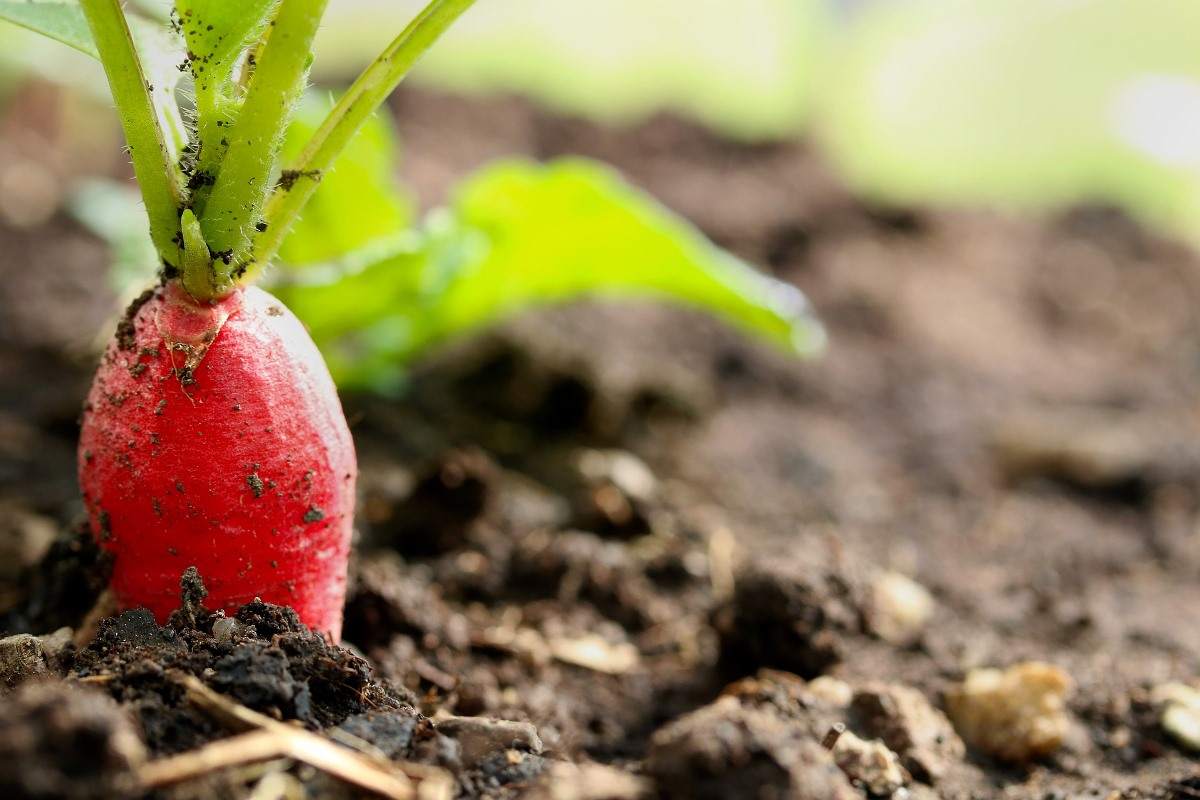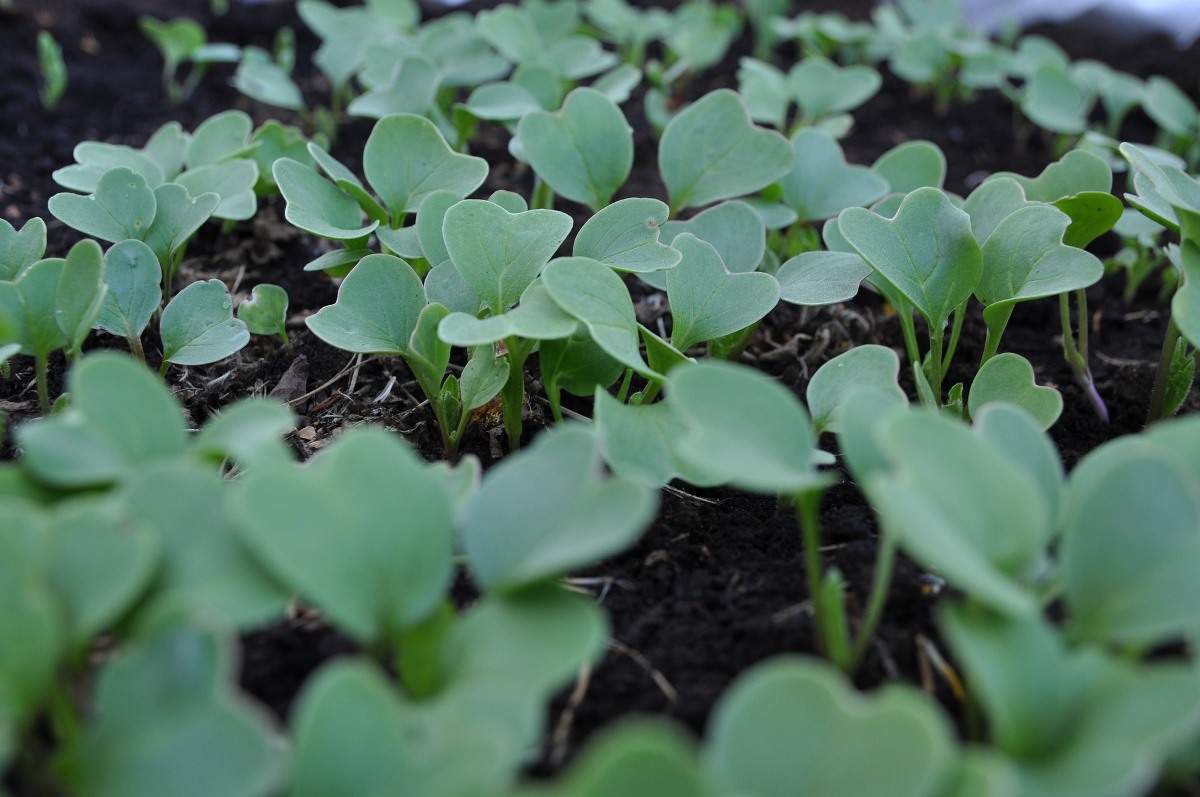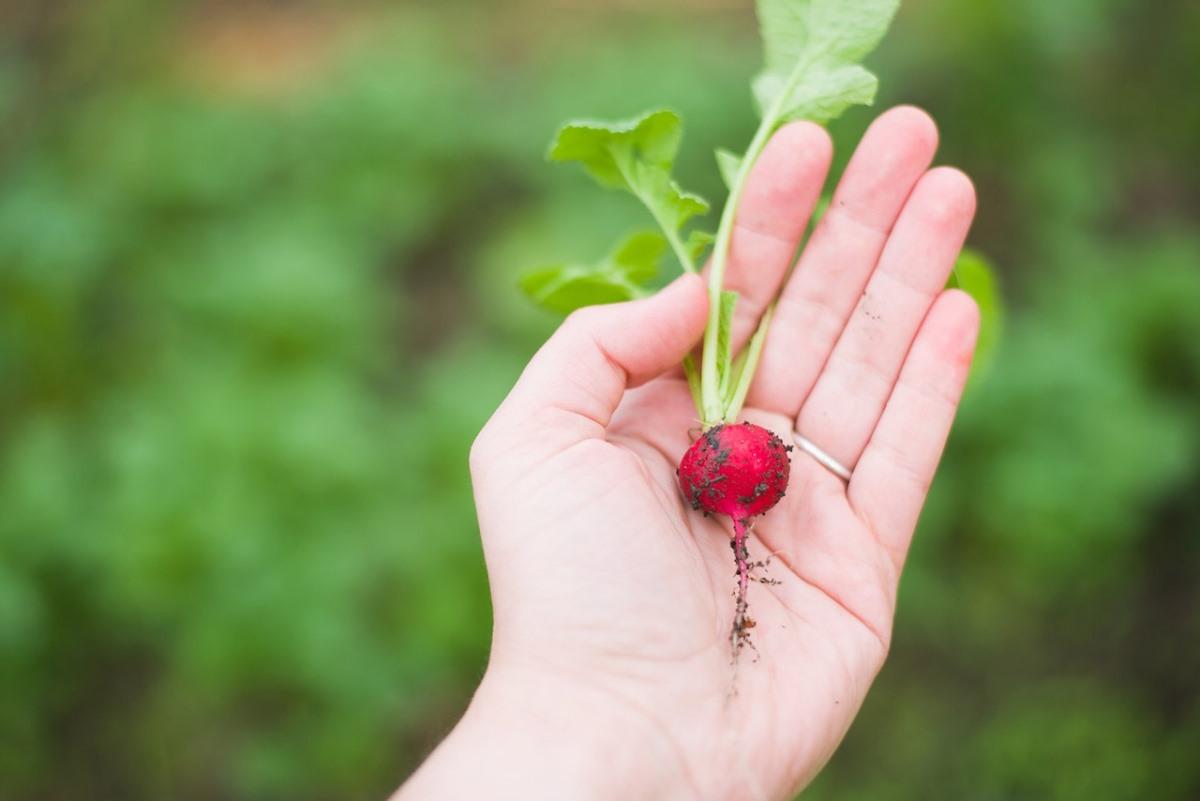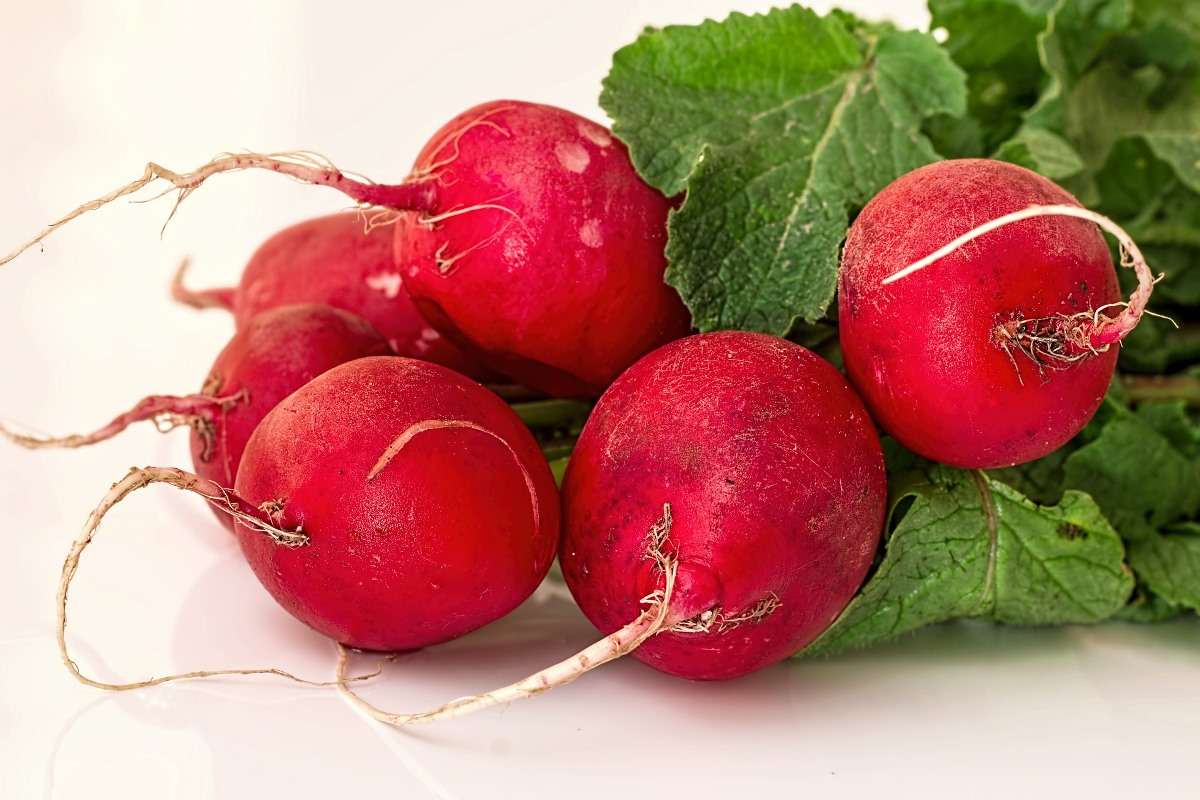Introduction to organic Radish farming
Radish is an edible root vegetable that belongs to the family of “Cruciferae”. It is a crop of tropical and temperate regions. It is a quick-growing biannual or annual herb. Its edible roots are having a different color from white to red. Organic Radish is one of the major salad vegetables grown all over the world. Its green leaves are a rich source of vitamin A and also be used as a green leaf vegetable.
A step by step guide to organic Radish farming
Organic farming is one type of production system which avoids the use of synthetically compounded fertilizers, growth regulators, pesticides, and livestock feed additives upon crop rotations, crop residues, legume green manures, off-farm organic waste, mineral-bearing rocks, animal manures, and biofertilizers to maintain soil productivity, tilth and to supply plant nutrients and biological means to control weed, insects and other pests.

The soil requirement for organic Radish farming
Sandy loam soils with high organic matter content are best suited for Radish cultivation. The highest yield can be obtained at a soil pH of 5.5 to 6.8. Roots of best flavor, size, and texture are developed at about 15°C. Ploughland thoroughly and make land clods and weed-free. Add well-decomposed cow dung of 5 to 10 tons/acre and mix well in soils at the time of land preparation. Avoid the use of undecomposed or free cow dung as it will lead to forking of fleshy roots.
The soil for organic Radish is thoroughly prepared so that there are no clods to interfere with root development. The soil must not contain any undecomposed organic matter because that may result in forking of roots or misshaped roots. Generally, first ploughing, about 30 cm deep is done with soil turning plough and remaining 4 to 5 ploughings are done with desi plough. Each ploughing should be followed by planking. Application of well-decomposed farmyard manure should preferably be done at the time of first ploughing.
Site preparation for organic Radish farming
Radish plants grow best in the spring and autumn and will tolerate light winter frosts. They need full to partial sun, ample water, and rich, fast-draining soil. Loosen the soil to a depth of 8 inches or even more and work in at least 10 pounds of good organic compost per 100 square feet. You can also add a little sand to improve friability and drainage.
Radishes like plenty of phosphorous so if you intend to add fertilizer before sowing, use something like bone meal. Too much nitrogen will discourage root bulbs and encourage heavy top growth. Kelp meal is loaded with micronutrients and will supply trace minerals to crops that will be consumed.
Radish seed rate per acre
For sowing of a one-acre land seed rate of 4 to 5 kg is sufficient. It is sown on the ridge for proper root development.
You can also check this: Organic Lettuce Farming, Growing Practices.

When to plant organic Radish
Radishes are particularly sensitive to any interruptions to their growth and consequently are the best direct-seeded outdoors. They are sensitive to frost, but if required, they can be sown indoors about 2 weeks before the first frost. If sown indoors, use a biodegradable pot so that you can plant the whole pot when it comes time to transplant them outdoors to minimize disruptions to their root system. Whether you plant indoors or out, the most important thing is to keep the soil moist. Sow seeds about ½ inch deep and about an inch apart, with 8 to 12 inches between rows, depending on how large your variety is. Once the Radishes begin to grow, you can thin them to about every 2-inch.
Radishes can be sown wherever there is a space, from early spring until early summer, and starting again in the early fall. They make useful “row markers” sown among slow germinating plants like carrots and parsnips. By the time the carrots or parsnips have germinated, it is close to the time to harvest the Radishes. Since they germinate in a few days, it makes weeding between the rows much easier.
Radish seed germination process
Radish seeds are good for around 4 years after you’ve purchased them. Radishes prefer cooler weather but can germinate in a very wide range of temps from 4 to 32°C. The optimal temperature range, though, is a more moderate 10 to 24°C. At these temps, the average time for your Radishes to pop out of the ground is about 5 to 10 days, depending on the weather. The soil needs to be moist all over the life of your Radishes. Usually, this isn’t a problem as they grow so well in the spring which is usually a damp time of year in many areas. The ideal weather for Radishes from seeding to harvesting is damp and about 10 to 18°C.
The process of organic Radish farming, growing methods
You should not miss this: Organic Cucumber Farming In Greenhopuse.

Step 1) To be successful in planting and growing Radish seeds, pay special attention to many factors. For the most part, Radish seed growth is best when they are planted in cool soil; early spring or fall is the preferred season for many varieties. Next, be sure to get the soil in good shape before planting loose, full of seasoned organic material, but not overly fertile.
Step 2) Moisture and soil depth must be right, too. Planting Radishes from seed works best if the soil is moist but does not have standing water; healthy plants will resist diseases and pests more readily. As for depth, Radish seed is sown very close to the surface, about ½ inches deep. Some experts recommend sprinkling the dirt on top of the seeds rather than trying to bury the seeds; that way they may be too deep.
Step 3) Radish plants must be thinned fairly often once the tops have reached a height of an inch or two. That practice allows enough room for the roots to grow round and firm. Sow seeds directly in the garden, 1/2-inch-deep, as soon as you can work the soil. Plant weekly to spread out the harvest over weeks, not days. Space rows 8 to 18 inches apart, planting eight to ten seeds per foot. Thin to one plant every 2 inches.
Step 4) Once planted, keep garden areas cool and well mulched with compost or aged animal manure. High temperatures and drought make this root crop tough, strong tasting, and prone to insect problems.
Organic manures and fertilizers for Radish farming
Radish is a quick-growing crop; hence the soil should be highly rich in plant nutrients. Add farmyard manure 25 to 40 tonnes, nitrogen 18 to 50 kg in the form of ammonium sulphate, phosphorus 50 kg in the form of superphosphate, and potash 50 kg in the form of muriate of potash for one hectare of the field.
At the time of field preparation, the farmyard manure must be mixed up carefully, whereas the complete doses of potassic phosphatic and one-half dose of nitrogenous fertilizers can be applied in the rows before sowing. And the remaining half dose of nitrogenous fertilizers must be applied as a top dressing along with irrigation when the plants start growing vigorously.
Organic agriculture is derived as a production system that largely excludes or completely avoids the use of synthetically compounded pesticides, growth regulators, fertilizers, preservatives, and livestock feed additives, organic agriculture practices thus rely upon the recycling of crop residues, off-farm organic residues, animal manure, and wastes. Organic agriculture is gaining movement in India due to the individual as well as group efforts to conserve environments and avoid contamination of the farm produce from the use of pesticides and chemical fertilizers. The important tenet of the organic food movement is that promotes ecological soundness and sustainable use of natural resources, also maintenance of crop diversity.
The problem of the high cost of chemical fertilizers fully meets the nutrient requirement of the crop by single-source, therefore, integrated nutrient management such as organic matters like vermicomposting, farmyard manure, poultry manure, and biofertilizer uses has become necessary. Farmyard manure is a huge organic material releases the soil compaction and increases the aeration in addition to the supply of essential organic matter and plant nutrients, thereby improving the soil microbial establishment along with the accumulation of excess humus content.
Irrigation requirement for organic Radish farming
Enough soil moisture must be available to help uniform seed germination and growth of the plant. If sufficient soil moisture is not available at the time of sowing, the first irrigation is given immediately after sowing. It is advantageous in the case of light soils but it hinders the germination in heavy soils. In such soils, the surface becomes dry with hard film formation before the seed sprouts. In this case, it is always safer if the sowing is done when already enough soil moisture is available for germination. Depending upon the season and the soil moisture availability, Radish may be irrigated once or twice a week. It should not be irrigated very frequently, but care must be taken that field does not become dry and compact and the root development is not checked.
Depending on which varieties of Radishes you are planting, watering requirements will vary. Watering requirements will also vary from year to year. Last year we had a cool, damp spring and summer, so we watered much less than normal. During hot weather, it’s a good idea to lay down an inch of water a couple of times a week on your summer Radish patch. Spring Radishes in our area rarely need water, but your area may be different. Just make sure the soil stays moist but not wet at least 6 inches down. Light watering of Radishes is almost useless. Make sure your water gets at least 6 inches into the soil.
Organic methods of controlling pests and diseases in Radish farming
Radish plants are related to cabbage and suffer from many of the same problems. Since leaves are not harvested, more insect damage can be tolerated on foliage than other vegetable crops. If holes or tunnels are found in the bulbs, suspect root maggots and treat using proven organic techniques.
Cabbage root maggots are a small-sized white-colored maggot that tunnels into your Radish roots. They come from a fly that looks like a common housefly but is a bit smaller. These small maggots are difficult to detect as your plants won’t wilt unless it is very hot and your plants are heavily infested, which is not common. Though, the quality of organic Radish crops will be compromised. Using row covers in the spring is one solution to keep the flies out, but you’ll need to put row covers on before your plants come up. Dusting the area with diatomaceous earth has been very successful against maggots.
Food grade diatomaceous earth, which is composed of powdered fossilized algae, has razor-sharp edges that are innocuous to most animals but fatal to insects. When insects such as slugs, thrips, fly maggots, aphids, caterpillars, grubs, or mites ingest diatomaceous earth, it punctures their guts and they die from dehydration.
Flea beetles are another type of garden pest that attacks Radish, among other garden produce. These tiny beetles chew holes in the leaves and stems of seedling which is when they’re most vulnerable and can weaken or kill the plants. Row covers are effective if they’re completely sealed with dirt or sandbags. Check under your row covers to make sure you beat the beetles to your plants and to make sure the weeds aren’t choking your plants either. Proper nutrition and watering also help your plants resist flea beetles. Ridding the area of bindweed and wild mustard also helps. One effective remedy for these beetles is powdering your plants with diatomaceous earth.
You can reduce the number of insect pests by attracting beneficial insects that eat harmful insects. Nearby young plants with collars made from cardboard bath tissue rolls or plastic cups can protect them from attacks by cutworms, and turning the soil before you plant will expose cutworms that are living underground so birds can more easily find and eat them. Using floating fabric row covers to maintain the insects away from the plants will help prevent infestations.
Splitting
Radish roots are prone to cracking in situations when the soil moisture is uneven. The root needs to develop at a steady pace. If this is followed by ample moisture, the plant is not able to cope with absorption and may split as a result. The solution is to keep the Radish bed evenly moist with very regular watering. Don’t skip a day or two and then flood the bed. Consistent moisture will minimize splitting.
Multiple taproots
While this can happen when excess potassium is out of balance in the soil, it’s more likely a response to the plants being crowded and competing for moisture and nutrients. It’s important to thin Radishes (and carrots) so each plant has adequate space to develop in the row.
WHen and how to harvest Radish

Radishes are at their best for a very short time. If they are left in the ground too long, they will develop a sharp taste and a pithy texture, and their roots will eventually split. Radishes are ready to harvest in as little as 20 days, depending on the variety. When the root has become plump, they are ready to pick. Harvest the entire crop once it matures, and store them in the refrigerator. If harvesting in hot weather, pull Radishes from the soil and drop into a bucket of cold water. Remove greens and refrigerate for up to 3 weeks. Storage can be extended up to several months in a properly maintained root cellar.
In case if you want to look at this: Growing Organic Potatoes In Backayard, Contianers.